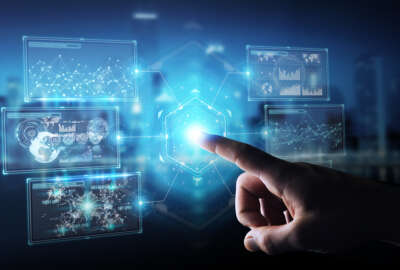Insight by Future Tech Enterprise
How federal contractors put users first — whether employee or fed — to deliver on government missions
Tech leaders from CACI, Future Tech Enterprise, MITRE and SAIC share insights on importance, benefits of taking user-centric approach to lifecycle management.
This is the second article in our IT lifecycle management series, Delivering the tech that delivers for government. It’s Part 1 of a two-part roundtable with enterprise tech leaders from CACI, Future Tech Enterprise, MITRE and SAIC.
“The end user is ultimately who’s providing the mission, who’s doing the work —is actually voting on the value of the IT system and if they can get their job done.”
It’s that straightforward, said Erik Nelson of CACI during a Federal News Network roundtable discussion on meeting the enterprise IT needs of employees.
When it comes to helping employees help the government, “we really focus in on: Is that value creation being delivered month over month, year over year, to the end user?” he said.
Nelson, senior vice president of CACI’s enterprise IT operating group, was not alone in this assertion. To a person, the roundtable participants agreed that a user- and customer-centric approach is at the core of their focus when it comes to meeting enterprise IT demands.
During the discussion for the Federal News Network series, Delivering the tech that delivers for government, they identified three demands their teams must address today and how that affects IT asset and lifecycle management across their enterprise infrastructure organizations — all of which serve thousands of users.
No. 1 demand: Meeting users when, where and how they want to work
“Everybody’s trying to support the mission,” pointed out Rick Schindel, leader of federal systems integrator programs at Future Tech Enterprise. “That requires a lot of flexibility, both in terms of keeping in mind technical debt that’s out there in order to make sure those users are operationally efficient and keeping in mind security, if they are working in a secure environment versus a non-secure environment — and sometimes even geographically. Where are they geographically?”
Plus, enterprise environments are hybrid now with cloud critical for supporting users wherever they work, at whatever the hour. Employees need the same suite of capabilities whether in the office, remote or on the move. Nelson, for instance, noted: “We hire people to contracts that are working service desk that never come in. I’ve never seen them. They work at home. So it’s kind of catapulted that work experience forward a lot.”
Definitely, mission enablement drives the selection of the tools and capabilities — and making sure that they’re available when needed, added Cedric Sims, senior vice president of enterprise innovation and integration at MITRE.
“We have different personas or archetypes within our organization, some are our research and development engineers, others we need to go to meet basic needs of our sponsors that we have within MITRE Corp.,” Sims said. “So to that end, we have to meet our laboratory needs as well as traditional desktop operational needs.”
To do that, federal contractors must keep that end user experience at the forefront, which makes the ability to monitor users and devices essential, said Bernie Tomasky, vice president of enterprise IT at SAIC.
“There’s some great digital experience monitoring tools out there now that really can take the guesswork out of how the performance is of the device. How long does it take to boot up your device? How long does it take to reach applications?” Tomasky said. “When you start to monitor that, you can start to then rightsize the devices that go out to the people and then also start doing proactive remediation — because you’re seeing the problem even before the end user sees it and starts to complain about it.”
Increasingly, users also want the ability to self-serve because always-on availability has become the expectation, he added. “And they really often want to solve some of their own problems themselves.”
No. 2 demand: Ensuring security across the enterprise without creating excessive friction
Maintaining security in these environments, where more capabilities and functionality are available on endpoints, also remains paramount, the roundtable participants said. Plus, government contractors must ensure that they can meet federal cyber mandates when working on programs and help their customers achieve those directives’ milestones as well.
“You have to balance the security requirements against the load that customers are experiencing, both in end user devices and in the data center infrastructure,” Schindel said. “It’s about managing that capability because you can’t overburden everybody.”
It’s been a benefit technologywise of the COVID-19 pandemic, Sims said. That forced a focus on enabling work while also providing security all with an eye to experience, he said. “We rearchitected aspects of our security architecture,” Sims said. “That allowed us to then have that same experience, even in a remote location, the same way that you would have in office.”
In fact, four years later, as MITRE has begun its own return-to-office efforts, it has refocused on the office experience because Sims said it discovered that the secure remote user experience had become a more robust and better experience than in office, he said.
CACI saw a similar expansion of secure capabilities in the wake of the pandemic, particularly in the classified communities it works in, Nelson said. “A lot of our customers working on military bases wanted to be able to do classified communications but couldn’t go in. It really catapulted that forward in those communities, and it hasn’t moved. They still like that approach.”
Standardization of endpoints and applications certainly helps as well, Tomasky added. SAIC now typically sets users at a higher security impact level for their devices.
“By going to a higher impact level — to secure your environment to a higher level classification with the customer — just makes it that much easier,” he said. “We try not to have to deal with supporting multiple levels. We just try to protect the data and go to a higher security level.”
No. 3 demand: Integrating holistically and effectively across the enterprise
Ultimately, creating a great experience for users across the enterprise, both in their own environments and those where they support customers, hinges on holistic integration, roundtable participants said.
“Communication breakdown is the biggest barrier to achieving results,” Nelson said. To avoid it requires strategy discussions internally and with government customers to bring challenges to the surface, he said, so that everyone can agree on what actually needs to be deployed. It’s critical because many platforms and products include modules that are not needed out the gate, if at all, he said.
“We actually established something called an integration cell on our programs — to get everybody to have that conversation because there are different points of view. You have to get it on the table to know whether it’s going to be successful,” Nelson said. “Everybody is allowed to have that conflict, but you stack hands and say, ‘OK, here’s how we’re going together. Goal number one, goal number two, et cetera.’ ”
Tomasky agreed that you have to drive the conversation from a desired outcomes viewpoint rather than from a technology perspective. “What are the mission outcomes I’m trying to achieve? Then map back from there to your strategy and which enabling technology to use.”
He noted that the agile DevSecOps approach that is taking hold in government provides that discovery phase. “You’re getting to the point of actually doing the discovery before you embark on that solution.”
Sims added that it’s also important to understand all the capabilities available in the platforms and products being used: “A lot of our platform providers are now offering overlapping capabilities, and so we find were buying the same thing multiple times. And that’s not desirous, right? … So we’re constantly trying to evaluate what our requirements are against the capabilities and the roadmaps of our vendors too.”
Because government programs often involve supporting multiple products or engaging with multiple contractors, gaining transparency into providers’ tools and capabilities matters, he said. Why? “To build and make better decisions on behalf of our federal customers.”
Clearly, agility and efficiency are more important than ever, Schindel said. For that reason, Future Tech’s focus is on helping government contractors and federal systems integrators be “more efficient, more capable, being able to leverage technology from the original equipment manufacturers in a more agreeable way, and then allowing you to see those efficiencies and cost savings to support your customer a little bit easier,” he said.
Discover more stories about how federal systems integrators and government contractors manage their enterprise infrastructure environments in our series Delivering the tech that delivers for government, sponsored by Future Tech Enterprise.
To listen to the full Part 1 discussion, click the podcast play button below:

Copyright © 2025 Federal News Network. All rights reserved. This website is not intended for users located within the European Economic Area.
Vanessa Roberts crafts content for custom programs at Federal News Network and WTOP. She’s been finding and telling B2B, government and technology stories in the nation’s capital since the era of the “sneakernet.” Vanessa has a master’s from the Columbia Graduate School of Journalism.






